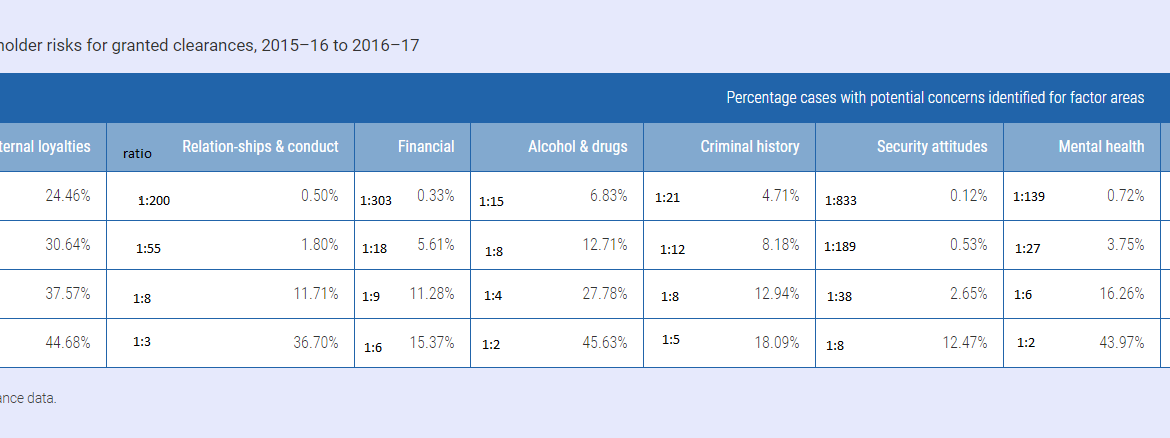The Home Affairs Adjudicative Guidelines are an important element to any suitability assessment. Here are the elements and concrete examples of each factor area and the frequency of detection.
1/7 Factor area:
External loyalties, influences and associations.
A security risk may exist when the clearance subject or their immediate family, including cohabitants, and other persons to whom he or she may be bound by affection, influence, or obligation are not Australian citizens or may be subject to duress.
Example suitability concerns / aggravating factors:
a. Foreign citizenship, contact with foreign nationals, or substantial financial interests or employment in foreign countries.
b. Involvement in, or association with persons or groups involved in, espionage, terrorism or politically motivated violence.
Example suitability mitigating factors:
a. Reasons for multiple citizenships are not a security concern.
b. Clearance subject was unaware of unlawful aims of an individual or organisation and severed ties upon learning of these.
2/7 Factor area:
Personal relationships and conduct
Sexual behaviour that involves a criminal offence, indicates a personality or emotional disorder, reflects a gross lack of judgment or discretion, or which may subject the clearance subject to undue influence or coercion, exploitation, or duress can raise questions about the clearance subject’s reliability, trustworthiness and maturity. Sexual orientation is not relevant to these considerations.
Example suitability concerns / aggravating factor:
a. Untrustworthy, unreliable or dishonest conduct.
Example suitability mitigating factors:
a. Conduct or contacts that create vulnerability to exploitation, such as high risk or criminal sexual behaviour.
b. Conduct occurred prior to or during adolescence and there is no evidence of subsequent similar conduct.
3/7 Factor area:
Financial considerations
Failure or inability to live within one’s means, satisfy debts, or meet financial obligations may indicate poor self-control, lack of judgment, or unwillingness to abide by rules and regulations. This may raise questions about a clearance subject’s honesty, trustworthiness, maturity, and vulnerability to coercion or influence.
Example suitability concerns / aggravating factors:
a. Inability to live within one’s means, satisfy debts or meet financial obligations.
Example suitability mitigating factors:
a. Initiated good-faith efforts to repay overdue creditors and otherwise resolve debts.
4/7 Factor area:
Alcohol and drug usage
Excessive alcohol consumption often leads to the exercise of questionable judgment or the failure to control impulses, and can raise questions about a clearance subject’s reliability and trustworthiness and ability to maintain discretion.
Example suitability concerns / aggravating factor:
a. Excessive alcohol consumption, use of illegal drugs or misuse of prescription drugs.
Example suitability mitigating factor:
a. Making satisfactory progress in treatment program and no history of relapse.
5/7 Factor area:
Criminal history and conduct
Criminal activity creates doubt about a person’s judgment, reliability, trustworthiness, maturity and honesty. By its very nature, it calls into question a person’s ability or willingness to comply with laws, rules and regulations.
Example suitability concerns / aggravating factor:
a. A criminal offence, multiple lesser offences, or association with criminals.
Example suitability mitigating factor:
a. So much time has elapsed that it is unlikely to recur.
6/7 Factor area:
Security attitudes and violations
Deliberate or negligent failure to comply with procedures, rules and regulations for protecting security classified or other sensitive information, including on information and communications technology (ICT) systems, raises doubt about a clearance subject’s trustworthiness, judgment, reliability, or willingness and ability to safeguard such information, and is a serious security concern.
Example suitability concerns / aggravating factor:
a. Deliberate or negligent non-compliance with security requirements, such as unauthorised use of ICT systems.
Example suitability mitigating factor:
a. Security violations were due to improper or inadequate training.
7/7 Factor area:
Mental health disorders
Certain emotional, mental, and personality conditions can impair judgment, reliability, or trustworthiness. A formal diagnosis of a disorder is not required for there to be a concern under this guideline.
Example suitability concerns / aggravating factor:
a. Certain emotional, mental and personality conditions that may impair judgement, reliability or trustworthiness, or failure to follow treatment advice related to a condition.
Example suitability mitigating factor:
a. Condition is readily controllable with treatment, and clearance subject has demonstrated ongoing and consistent compliance with treatment plan.
CONCLUSION:
So what?
When any of the above issues make a case complex, it may mean that experienced official vetting officers have recommended the clearance to be withheld (a CL equivalent of “1/5: No Way”). As Table 2.4 below indicates, when cases turn complex, it causes significant delays to reach a final decision, consuming lots of effort and potentially frustrating Sponsors and Candidates.
Faster, Cheaper: Same Vetting Officers, Same Standards:
Instead of taking 18-26 months to complete a complex case, you can know faster (within 1-10 days).

NB:
Your organisation does not need to be involved in direct government-related work to benefit from having your people obtain our suitability clearance. You only need to have people who are in a position of trust.
Action:
Talk to use today about how we can help safeguard your organisation by using the same character standards that the government uses when it puts people into positions of trust.
Here is a comparison table outlining the differences between the 2018 Adjudicative Guidelines and the 2024 Adjudicative Standards across the seven core risk factor areas:
| Risk Factor Areas | 2018 Adjudicative Guidelines | 2024 Adjudicative Standards |
|---|---|---|
| External Loyalties, Influences, and Associations | Considered foreign associations broadly, disqualification if influence potential was high. Limited specific mention of foreign preference behaviors. | Expanded with specific disqualification for strong foreign associations, voting in foreign elections, and dual citizenship activities that may imply foreign preference. |
| Personal Relationships and Conduct | Focused on trustworthiness, disqualifying actions that indicate untrustworthiness or dishonesty. Limited scope on criminal associations. | Explicit inclusion of criminal associations and patterns of dishonesty or rule violations as disqualifying. Expanded to include rehabilitation programs as mitigating factors. |
| Financial Considerations | Evaluated general financial irresponsibility as a risk, less emphasis on rapid affluence as an indicator. | Detailed rapid wealth accumulation as a specific risk factor and patterns of debt delinquency; financial counseling added as a mitigation. |
| Alcohol and Drug Use | Considered habitual abuse broadly disqualifying but did not always specify workplace incidents. | Specific inclusion of workplace incidents involving substance abuse, along with sustained rehabilitation and time-lapse as mitigating factors. |
| Criminal History and Conduct | Addressed criminal behavior broadly; serious or frequent criminal activity was disqualifying. | Emphasis on disqualification for serious or multiple offenses, with clear guidelines for time-passed and rehabilitation as mitigation. |
| Security Attitudes and Violations | General mention of unauthorized disclosure; repeated security breaches noted as risks. | Clear disqualification for unauthorized disclosure, with specific focus on retraining and harm assessment as mitigating elements. |
| Emotional and Mental Health Issues | Focused on untreated mental health issues broadly without explicit guidelines on rehabilitation or behavioral indicators. | Detailed disqualification for untreated, impactful mental health issues and behavioral indicators, with engagement in treatment programs as mitigating factors. |
This table highlights the refined criteria in the 2024 standards, emphasizing specific disqualification and mitigation conditions for each risk area.






